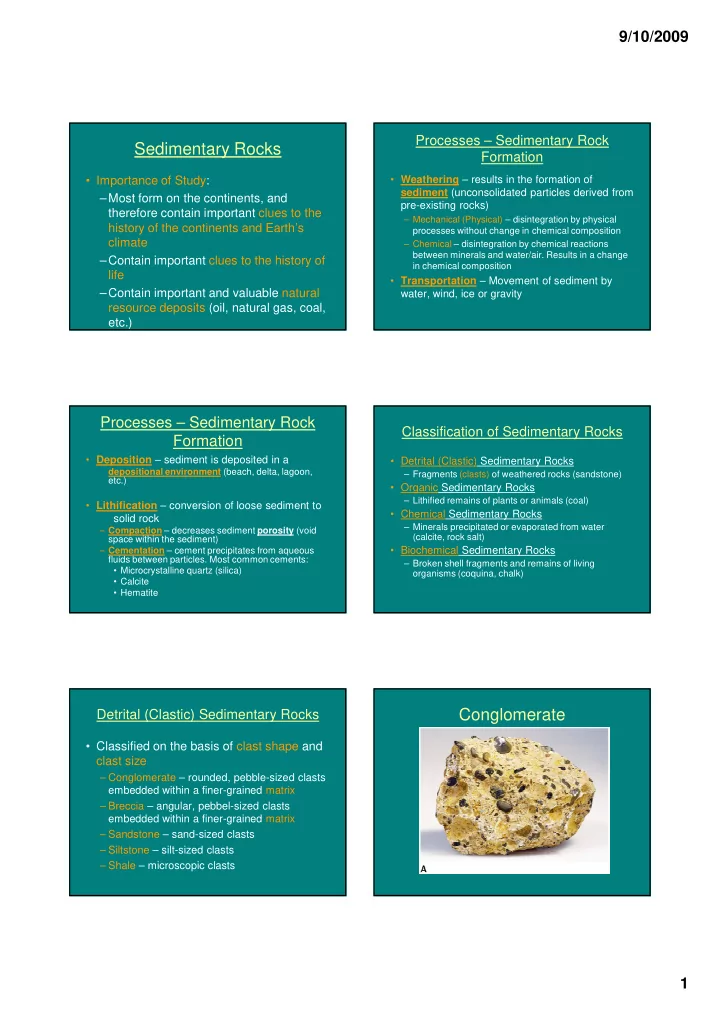

9/10/2009 Processes – Sedimentary Rock Sedimentary Rocks Formation • Importance of Study: • Weathering – results in the formation of sediment (unconsolidated particles derived from –Most form on the continents, and pre-existing rocks) therefore contain important clues to the – Mechanical (Physical) – disintegration by physical history of the continents and Earth’s processes without change in chemical composition climate – Chemical – disintegration by chemical reactions between minerals and water/air. Results in a change –Contain important clues to the history of in chemical composition life • Transportation – Movement of sediment by –Contain important and valuable natural water, wind, ice or gravity resource deposits (oil, natural gas, coal, etc.) Processes – Sedimentary Rock Classification of Sedimentary Rocks Formation • Deposition – sediment is deposited in a • Detrital (Clastic) Sedimentary Rocks depositional environment (beach, delta, lagoon, – Fragments (clasts) of weathered rocks (sandstone) etc.) • Organic Sedimentary Rocks – Lithified remains of plants or animals (coal) • Lithification – conversion of loose sediment to • Chemical Sedimentary Rocks solid rock – Minerals precipitated or evaporated from water – Compaction – decreases sediment porosity (void (calcite, rock salt) space within the sediment) – Cementation – cement precipitates from aqueous • Biochemical Sedimentary Rocks fluids between particles. Most common cements: – Broken shell fragments and remains of living • Microcrystalline quartz (silica) organisms (coquina, chalk) • Calcite • Hematite Conglomerate Detrital (Clastic) Sedimentary Rocks • Classified on the basis of clast shape and clast size – Conglomerate – rounded, pebble-sized clasts embedded within a finer-grained matrix – Breccia – angular, pebbel-sized clasts embedded within a finer-grained matrix – Sandstone – sand-sized clasts – Siltstone – silt-sized clasts – Shale – microscopic clasts 1
9/10/2009 Breccia Sandstone Siltstone Shale Chemical Sed. Rock – Travertine Chemical Sed. Rock – Crystalline (precipitate) Limestone (precipitate) 2
9/10/2009 Chemical Sed. Rock – Gypsum Chemical Sed. Rock – Chert (precipitate) (evaporite) Chemical Sed. Rock – Rock Salt Gypsum Deposit (evaporite) (evaporite) Biochemical Sed. Rock – Fossiliferous Salt Flat (evaporite) Limestone 3
9/10/2009 Biochemical Sed. Rock - Chalk Biochemical Sed Rock - Coquina Formation of Coal (organic) Organic Sed. Rock - Coal Sedimentary Structures Common Sedimentary Structures • Features that develop during or shortly after • Bedding (stratification) – horizontal layering deposition of sediment. Are important clues to – Most common sedimentary structure sediment transportation and depositional • Ripple Marks – small, nearly parallel ridges and environments. troughs formed by currents moving back and – Climate (temperature, rainfall, etc) forth – Geologic setting (beach, lagoon, desert, river, etc.) • Cross Bedding – layers of sediment inclined in – Ecological environment in which fossilized the current direction animals/plants were living • Mud Cracks – Geologic setting in which hydrocarbons (oil, natural – Indicate wet environment that periodically dries gas) are likely to have developed • Fossils – Important indicators of sedimentary environment 4
9/10/2009 Ripple Marks Bedding (Stratification) Cross Bedding Cross Bedding Mud Cracks Fossils 5
9/10/2009 Conglomerate Interpretation of Textural Features • Clast Size – transportation of large clasts requires more energy than transportation of small clasts – Large clasts = ‘high energy’ transporting agent (fast moving river with rapids) • Deposited closest to source of sediment – Small clasts = ‘low energy’ transporting agent (slow moving river) • Deposited farther from source of sediment Siltstone Interpretation of Textural Features • Clast Shape – During process of sediment transportation, abrasion of grains results in progressive ‘rounding’ in shape. – Rounded clasts = traveled greater distance from source – Angular clasts = traveled short distance from source Effects of Progressive Abrasion on Breccia Clast Shape 6
9/10/2009 Conglomerate Interpretation of Mineralogical Composition – Time of sediment transport – Mechanism of sediment transport – Climate of sediment deposition – Geologic setting of sediment deposition Interpretation of Mineralogical Composition Interpretation of Mineralogical Composition – Detrital Rocks – Detrital Rocks 3) Warm and wet weathering, transportation, and 1) Quartz-rich rocks represent longest periods deposition climates/environments most rapidly and distances of sediment transportation. remove Fe-, Mg-, Ca-rich minerals (olivine, (‘Low temp.’ quartz is very stable at Earth’s pyroxene, Ca-plagioclase) from the sediment surface.) (Chemical weathering is most active in warm, wet climates/environments) 2) Fe-, Mg-, Ca- rich rocks represent short periods and distances of sediment transportation. 4) Dry and cold weathering, transportation, and deposition climates/environments allow Fe-, Mg- (‘High temp.’ Ca-, Fe-, Mg- rich minerals (olivine, , Ca-rich minerals to ‘survive’ in the sediment. pyroxene, amphibole, Ca-plagioclase) are not (Chemical weathering is least active in cold, dry stable at Earth’s surface.) climates/environments) Feldspar & amphibole-rich Quartz-rich sandstone sandstone 7
9/10/2009 Interpretation Mineralogical Composition – Chemical Rocks • Mineralogical Composition may also be a clue to depositional environment – Example: Calcite – most precipitates from warm ocean waters – Example: Halite – most forms by evaporation of marine waters Common Cements • Silica (microcrystalline quartz) – Most likely to form in quartz-rich clastic rocks • Calcite – Most likely to form in calcite-rich chemical and biochemical rocks • Fe-oxide (hematite) – Most likely to form in clastic rocks with high Fe-bearing mineral (biotite, amphibole) content What is the most likely depositional Which rock was most likely deposited environment of? closest to the source of sediment? • White, quartz-rich sandstone with a silica • Course-grained breccia, or a sandstone cement? with well-rounded quartz grains? • Fossiliferous limestone with a calcite cement? • Quartz - rich sandstone, or an olivine - • Coquina? pyroxene – rich sandstone? • Feldspar-rich mudstone? 8
9/10/2009 What was the depositional environment for What was the depositional environment for sandstones and conglomerates of the Cumberland Middle Tennessee limestones Plateau? 9
Recommend
More recommend